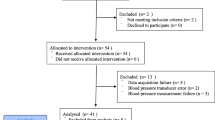Abstract
A pneumoperitoneum during laparoscopic procedures has deleterious effects on cerebral perfusion and oxygenation. Our aim was to assess the effects of different insufflation pressures on cerebral oxygen saturation (rSO2) using a noninvasive INVOS Cerebral Oximeter (Somanetics Corporation, USA) system. One hundred patients scheduled for laparoscopic cholecystectomy were included and divided into two groups: a 10 mmHg pneumoperitoneum group (group I) and a 14 mmHg pneumoperitoneum group (group II). The rSO2 measurements were obtained preinsufflation, after insufflation, every 15 min after insufflation, and 10 min after desufflation. Hemodynamic variables and anesthesia and surgery times were recorded. Between the two groups, there were no statistically significant differences in terms of age, sex, weight, anesthesia times, or surgery times (p > 0.05). The hemodynamic variables were similar in the two groups (p > 0.05). The rSO2 value changed over time, with a statistically significant between-group difference (p = 0.001). The preinsufflation rSO2 value was 70.07 ± 7.73 in group I and 72.21 ± 6.58 in group II, with no significant between-group difference (p > 0.05). After insufflation, the rSO2 value decreased to 69.60 ± 7.74 in group I and 64.41 ± 6.48 in group II, and the distinction was statistically significant (p < 0.001). A high-pressure pneumoperitoneum was associated with a greater decrease in rSO2 as compared to a low-pressure pneumoperitoneum. Thus, we suggest the use of a low-pressure pneumoperitoneum in patients with central nervous system pathologies.
Similar content being viewed by others
References
Soper NJ (1993) Laparoscopic general surgery: past, present and future. Surgery 113:1–3
Alishahi S, Francis N, Crofts S, Duncan L, Bickel A, Cushieri A (2001) Central and peripheral adverse hemodynamic changes during laparoscopic surgery and their reversal with a novel intermittent sequential pneumatic compression device. Ann Surg 233:176–182
Kanwer DB, Kaman L, Nedounsejiane M, Medhi B, Verma GR, Bala I (2009) Comparative study of low pressure versus standard pressure pneumoperitoneum in laparoscopic cholecystectomy--a randomised controlled trial. Trop Gastroenterol 30:171–174
Kurukahvecioglu O, Sare M, Karamercan A, Gunaydin B, Anadol Z, Tezel E (2008) Intermittent pneumatic sequential compression of the lower extremities restores the cerebral oxygen saturation during laparoscopic cholecystectomy. Surg Endosc 22:907–911
Lee JR, Lee PB, Do SH, Jeon YT, Lee JM, Hwang JY, Han SH (2006) The effect of gynaecological laparoscopic surgery on cerebral oxygenation. J Int Med Res 34:531–536
Gipson CL, Johnson GA, Fisher R, Stewart A, Giles G, Johnson JO, Tobias JD (2006) Changes in cerebral oximetry during peritoneal insufflation for laparoscopic procedures. J Minim Access Surg 2:67–72
Nielsen HB (2014) Systematic review of near-infrared spectroscopy determined cerebral oxygenation during non-cardiac surgery. Front Physiol 17:1–15
Veekash G, Wei LX, Su M (2010) Carbon dioxide pneumoperitoneum, physiologic changes and anesthetic concerns. Ambul Surg 16:41–46
Schob OM, Allen DC, Benzel E, Curet MJ, Adams MS, Baldwin NG, Largiader F, Zucker KA (1996) A comparison of the pathophysiologic effects of carbon dioxide, nitrous oxide, and helium pneumoperitoneum on intracranial pressure. Am J Surg 172:248–253
Cooke SJ, Paterson-Brown S (2001) Association between laparoscopic abdominal surgery and postoperative symptoms of raised intracranial pressure. Surg Endosc 15:723–725
Bloomfield GL, Ridings PC, Blocher CR, Marmarou A, Sugerman HJ (1997) A proposed relationship between increased intra-abdominal, intrathoracic, and intracranial pressure. Crit Care Med 25:496–503
Moncure M, Salem R, Moncure K, Testaiuti M, Marburger R, Ye X, Brathwaite C, Ross SE (1999) Central nervous system metabolic and physiologic effects of laparoscopy. Am Surg 65:168–172
Eryılmaz HB, Memiş D, Sezer A, Inal MT (2012) The effects of different insufflation pressures on liver functions assessed with LiMON on patients undergoing laparoscopic cholecystectomy. ScientificWorldJournal 2012:172575
Ito N, Nanto S, Nagao K, Hatanaka T, Nishiyama K, Kai T (2012) Regional cerebral oxygen saturation on hospital arrival is a potential novel predictor of neurological outcomes at hospital discharge in patients with out-of-hospital cardiac arrest. Resuscitation. 83:46–50
Slater JP, Guarino T, Stack J, Vinod K, Bustami RT, Brown JM et al (2009) Cerebral oxygen desaturation predicts cognitive decline and longer hospital stay after cardiac surgery. Ann Thorac Surg 87:36–44
Mobbs RJ, Yang MO (2002) The dangers of diagnostic laparoscopy in the head injured patient. J Clin Neurosci 9:592–593
Rosenthal RJ, Friedman RL, Kahn AM, Martz J, Thiagarajah S, Cohen D, Shi Q, Nussbaum M (1998) Reasons for intracranial hypertension and hemodynamic instability during acute elevations of intra-abdominal pressure: observations in a large animal model. J Gastrointest Surg 2:415–425
Rosenthal RJ, Hiatt JR, Phillips EH, Hewitt W, Demetriou AA, Grode M (1997) Intracranial pressure. Effects of pneumoperitoneum in a large-animal model. Surg Endosc 11:376–380
Jobsis FF (1977) Noninvasive, infrared monitoring of cerebral and myocardial oxygen sufficiency and circulatory parameters. Science. 198:1264–1267
Owen-Reece H, Smith M, Elwell CE, Goldstone JC (1999) Near infrared spectroscopy. Br J Anaesth 82:418–426
Levy WJ, Levin S, Chance B (1995) Near-infrared measurement of cerebral oxygenation. Correlation with electroencephalographic ischemia during ventricular fibrillation. Anesthesiology 83:738–746
Lovell AT, Owen-Reece H, Elwell CE, Smith M, Goldstone JC (1999) Continuous measurement of cerebral oxygenation by near infrared spectroscopy during induction of anesthesia. Anesth Analg 88:554–558
Plachky J, Hofer S, Volkmann M, Martin E, Bardenheuer HJ, Weigand MA (2004) Regional cerebral oxygen saturation is a sensitive marker of cerebral hypoperfusion during orthotopic liver transplantation. Anesth Analg 99:344–349
Dexter SP, Vucevic M, Gibson J, McMahon MJ (1999) Hemodynamic consequences of high- and low-pressure capnoperitoneum during laparoscopic cholecystectomy. Surg Endosc 13:376–381
Joris JL, Noirot DP, Legrand MJ, Jacquet NJ, Lamy ML (1993) Hemodynamic changes during laparoscopic cholecystectomy. Anesth Analg 76:1067–1071
Funding
This work was supported by the University of Trakya research grant no. TUBAP 2012/84.
Author information
Authors and Affiliations
Corresponding author
Ethics declarations
The authors declare that they have no conflict of interest.
Additional information
Publisher’s Note
Springer Nature remains neutral with regard to jurisdictional claims in published maps and institutional affiliations.
Rights and permissions
About this article
Cite this article
Inal, M.T., Memis, D., Sezer, A. et al. The Effects of Different Insufflation Pressures on Cerebral Oxygen Saturation in Patients Undergoing Laparoscopic Cholecystectomy. Indian J Surg 82, 377–381 (2020). https://doi.org/10.1007/s12262-019-01973-6
Received:
Accepted:
Published:
Issue Date:
DOI: https://doi.org/10.1007/s12262-019-01973-6




